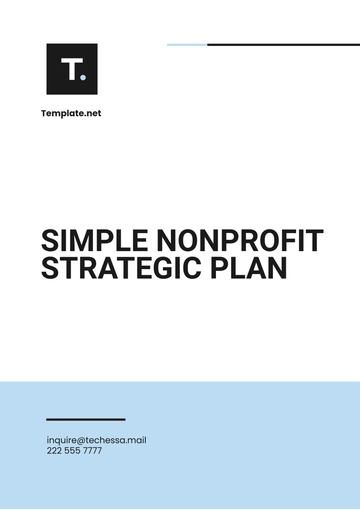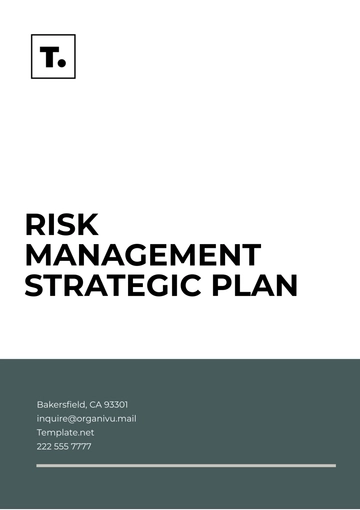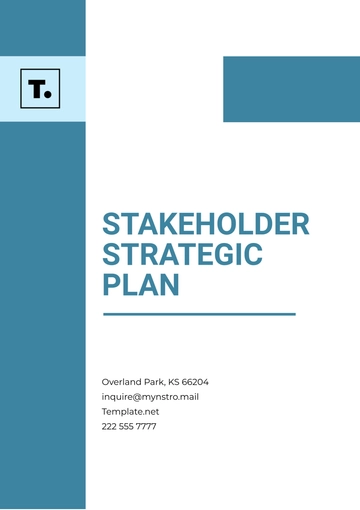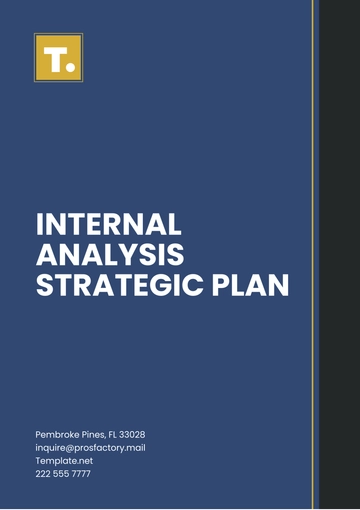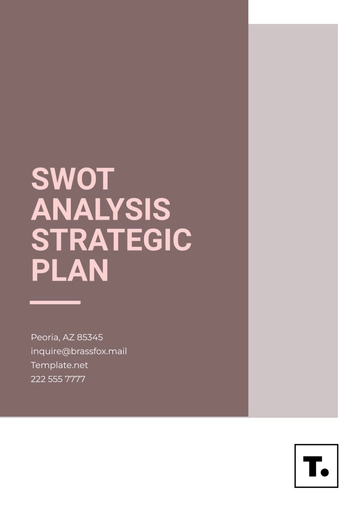Free Strategic Risk Planning
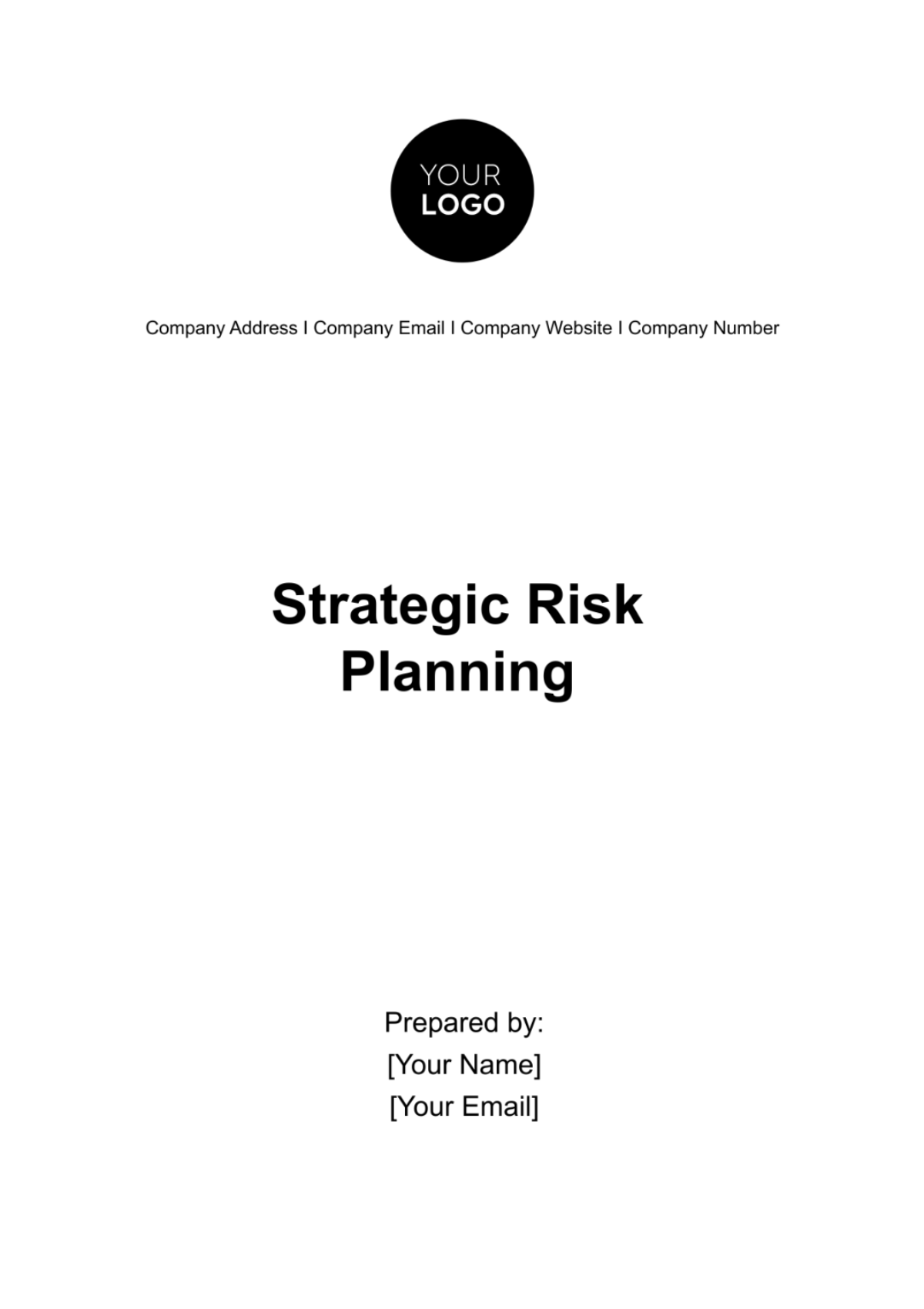
I. Executive Summary
The strategic risk plan at [Your Company Name] serves as a guide for navigating through potential risks that could impact various facets of the organization. It is meticulously designed to identify, assess, and manage risks, ensuring a proactive approach to potential challenges. This plan is integral in fortifying the company’s defenses against unforeseen events that could hinder its operations or growth trajectory.
The plan covers a wide spectrum of risks, including operational, strategic, financial, and compliance-related risks. It encompasses methodologies for both identifying emerging risks and reassessing known risks periodically, ensuring a dynamic and adaptive risk management process. The plan also integrates the latest industry best practices and tools for risk assessment and mitigation.
Plan Objectives
The primary aim of the plan is to protect [Your Company Name]'s valuable assets, including physical resources, intellectual property, and human capital. By identifying potential threats to these assets and implementing effective countermeasures, the plan contributes to preserving the company's competitive position in the market.
This plan includes strategies to manage risks that could harm the company's public image and stakeholder relationships. Proactive reputation management is key to maintaining customer trust and business integrity.
By anticipating and managing potential risks, the plan aims to minimize unexpected financial losses and operational disruptions. Simultaneously, it focuses on recognizing and capitalizing on opportunities that arise from a well-managed risk environment. This dual focus supports the company's sustainable growth and long-term success.
II. Risk Identification
This section outlines the process of identifying various types of risks that could affect the company, setting the foundation for effective risk management.
A. Risk Categories
We categorize risks into four main areas: operational, strategic, financial, and compliance/legal risks. Understanding these categories helps in systematically identifying potential risks.
Risk Area | Description |
Operational Risks | They arise from process failures, human errors, or system disruptions, affecting business efficiency and productivity. Mitigation includes process audits, employee training, and recovery plans. |
Strategic Risks | These include market strategies and major business decisions, with risks of misalignment with market demands. Addressing these involves market research, regular strategy reviews, and adaptive planning. |
Financial Risks | Arising from market volatility and financial mismanagement, they impact cash flow and investor confidence. Management includes budget control, financial modeling, and regular audits. |
Compliance/Legal Risks | Non-compliance risks legal penalties and reputational damage. This area requires continuous legal monitoring, compliance programs, and employee legal training. |
B. Risk Sources
Internally, risks can arise from areas like human resources, technology, or operational processes. Externally, market fluctuations, legal changes, and environmental factors are significant sources. Regular analysis of these sources enables the early identification of potential risks.
Risk Source Type | Mitigation Approach |
Internal Risks | Regular HR assessments, IT security upgrades, process optimization reviews. |
External Risks | Market trend analysis, legal compliance monitoring, environmental risk assessments. |
III. Risk Assessment
Risk assessment involves evaluating the identified risks to understand their potential impact and likelihood, essential for prioritizing responses.
A. Risk Evaluation Criteria
We evaluate risks based on their potential impact on business objectives and their likelihood of occurrence. This evaluation helps in understanding the severity and urgency of each risk.
Criteria | Role in Risk Assessment |
Likelihood of Occurrence | High-likelihood risks are prioritized for action. Lower likelihood risks may be monitored or accepted based on availability. |
Potential Impact on Business | High-impact risks require comprehensive mitigation strategies. Lower impacts might be accepted or mitigated with less intensive measures. |
B. Risk Prioritization
Using a risk matrix, we prioritize risks by categorizing them as high, medium, or low priority.
Risk Level | Risk Matrix Criteria |
High Priority | High likelihood & high impact. Requires immediate attention. |
Medium Priority | Moderate likelihood & impact. Requires monitoring and planned response. |
Low Priority | Low likelihood & low impact. May be accepted or require minimal action. |
IV. Risk Mitigation Strategies
Developing risk mitigation strategies is key to managing and minimizing the impact of identified risks on the company.
A. Risk Response Planning
For each identified risk, we develop a tailored response strategy. This might include risk avoidance, mitigation, transfer, or acceptance, depending on the nature and severity of the risk.
Risk Response Strategy | Description | Applicable When |
Risk Avoidance | Eliminating the risk by avoiding activities that create the risk. | For high-impact risks that can be entirely avoided by altering strategies or plans. |
Risk Mitigation | Implementing measures to reduce the likelihood or impact of the risk. | For risks that are likely and impactful but can be lessened through proactive measures. |
Risk Transfer | Transferring the risk to a third party, such as through insurance. | Typically for financial risks where transferring the risk is more cost-effective. |
Risk Acceptance | Accepting the risk when its impact is considered negligible or manageable. | For low-priority risks where the cost of mitigation exceeds the potential loss. |
B. Resource Allocation
Resources are strategically allocated to address the prioritized risks. This includes financial resources, personnel, and technology, ensuring that risk mitigation efforts are adequately supported.
Resource Type | Purpose in Risk Mitigation | Allocation Strategy |
Financial Resources | Allocated to fund risk mitigation activities. | Budget allocation based on risk prioritization, ensuring high-priority risks receive adequate funding. |
Personnel | Dedicated personnel for risk management tasks. | Assigning or hiring risk management specialists and providing training to existing staff. |
Technology | Investment in technology to monitor risks, enhance security measures, or improve process efficiency. | Investing in advanced software, hardware, or systems that support risk management efforts. |
V. Implementation Plan
The implementation plan outlines specific actions to execute the risk mitigation strategies, emphasizing accountability and effectiveness.
A. Action Items
Each risk mitigation strategy is broken down into actionable steps, with clear timelines and milestones for implementation.
Risk Mitigation Strategy | Actionable Steps | Timelines and Milestones |
Cybersecurity Enhancement | Upgrade security software, conduct employee cyber training, establish a response protocol for data breaches. | Software upgrade within [3 months], training completion in [6 months], protocol ready in [1 month]. |
Workplace Safety Improvement | Implement safety training, install safety equipment, conduct regular safety audits. | Training rollout in [2 months], equipment installation in [4 months], first audit in [6 months]. |
Regulatory Compliance | Update policies to comply with new regulations, train staff on compliance, schedule regular compliance reviews. | Policy update in [1 month], staff training in [3 months], first review in [6 months]. |
Supply Chain Risk Management | Diversify suppliers, establish a risk monitoring system, develop contingency plans for supply disruption. | Supplier diversification in [6 months], monitoring system setup in [4 months], contingency plan in [3 months]. |
Financial Risk Control | Conduct financial health assessments, develop debt management plans, monitor market trends for investment risks. | Assessment every quarter, debt plan within [1 month], ongoing market monitoring. |
B. Responsibility Assignment
Responsibilities for executing each action item are assigned to specific team members or departments, ensuring clear accountability and efficient execution.
Action Item | Assigned To | Responsibility Description |
Cybersecurity Software Upgrade | IT Department | The IT Department is responsible for evaluating, selecting, and implementing the upgraded cybersecurity software. |
Safety Training Implementation | Human Resources | Human Resources oversees the development and rollout of safety training programs, ensuring all employees complete the training as scheduled. |
Regulatory Policy Update | Legal and Compliance Team | The Legal and Compliance Team updates the company policies to align with new regulations and ensures staff are trained on compliance. |
Supply Chain Risk Monitoring | Operations and Procurement | Operations and Procurement are tasked with diversifying suppliers and setting up a risk monitoring system for the supply chain. |
Financial Risk Assessment | Finance Department | The Finance Department conducts regular financial health assessments and develops strategies to manage and mitigate financial risks. |
- 100% Customizable, free editor
- Access 1 Million+ Templates, photo’s & graphics
- Download or share as a template
- Click and replace photos, graphics, text, backgrounds
- Resize, crop, AI write & more
- Access advanced editor
Optimize risk management strategies with Template.net's Strategic Risk Planning Template. This editable and customizable tool provides a structured framework for identifying, assessing, and mitigating risks. Utilize our intuitive Ai Editor Tool to tailor the plan to your organization's specific needs effortlessly, ensuring resilience and strategic decision-making in uncertain environments.

